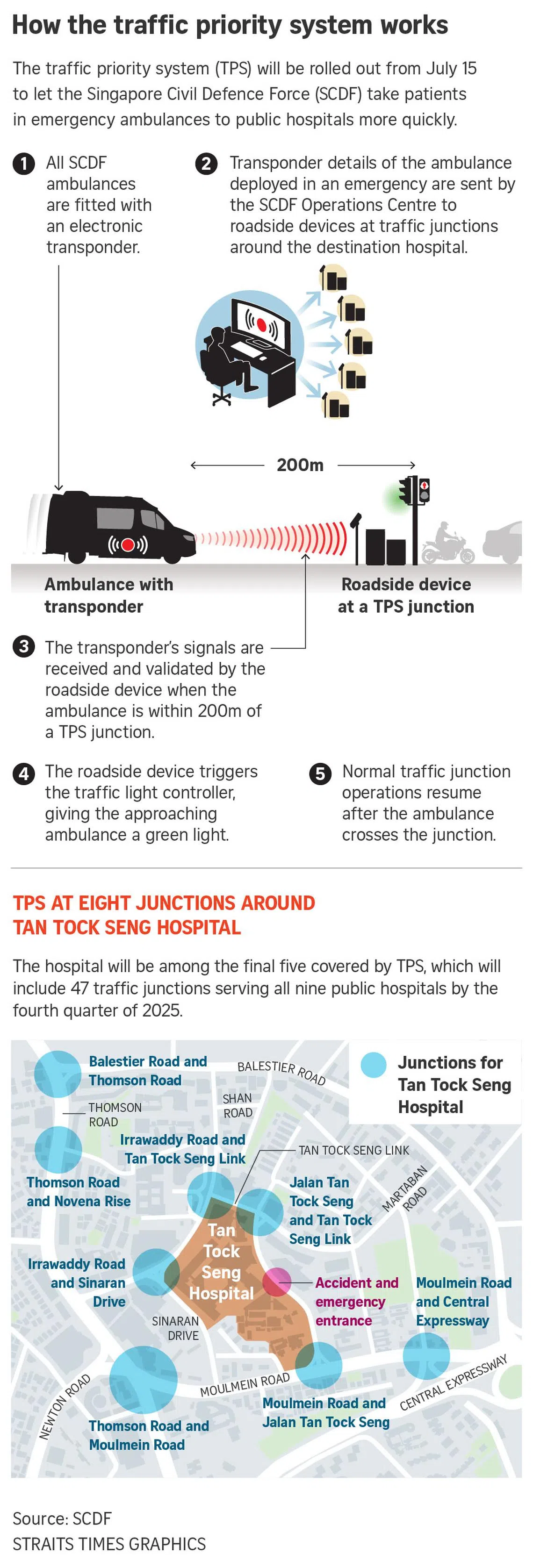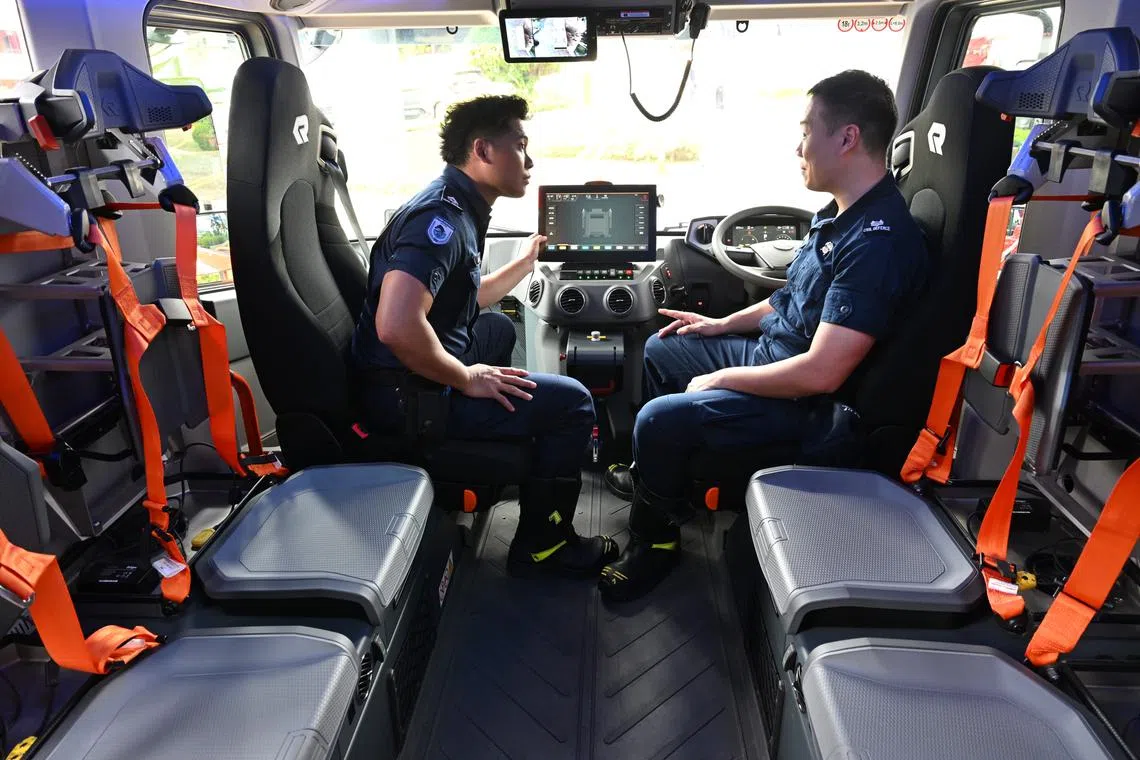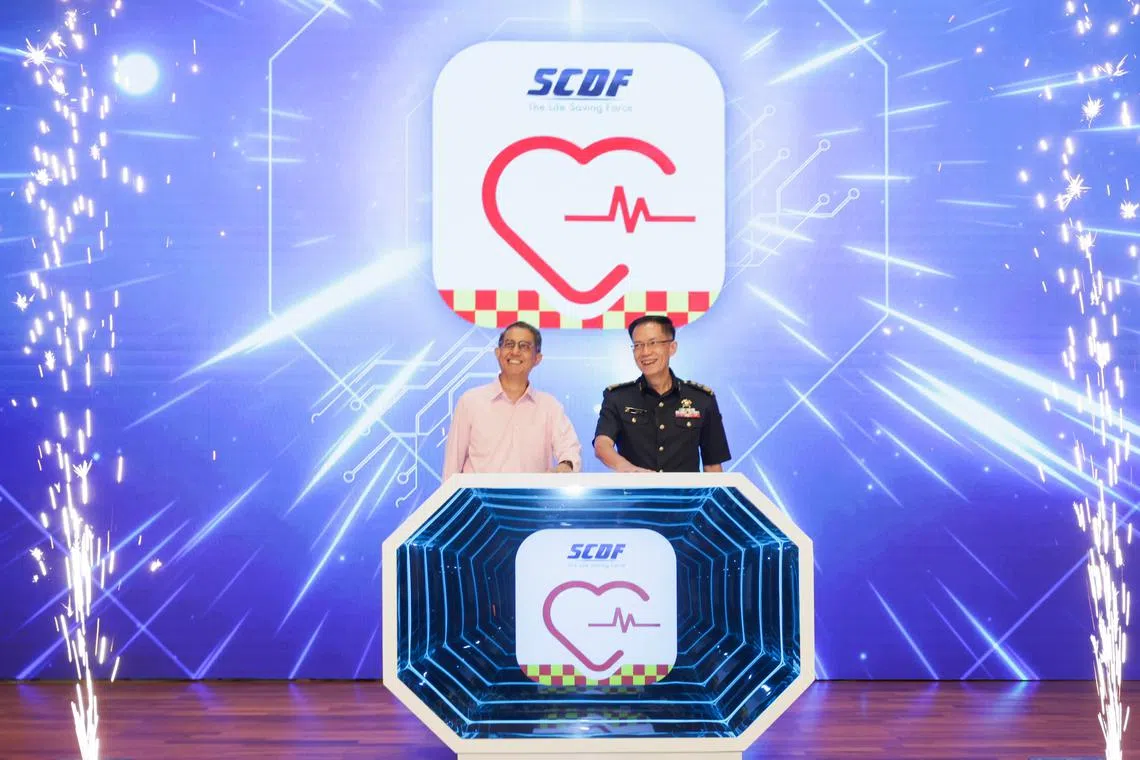New ‘green light’ traffic priority system for SCDF ambulances to reach hospitals faster
Sign up now: Get ST's newsletters delivered to your inbox

The traffic signal priority for SCDF ambulances gives them a “green light” path to the hospital.
ST PHOTO: ALPHONSUS CHERN
Follow topic:
SINGAPORE - Ambulances taking emergency patients to Ng Teng Fong General Hospital will be able to do so more quickly from the middle of July, with a new traffic priority system (TPS) the Singapore Civil Defence Force (SCDF) unveiled on July 4.
The system will give SCDF ambulances priority at traffic lights, so they have a “green light” path to the hospital and can avoid getting stuck in traffic at junctions near hospitals or having to run red lights.
It will allow patients to get treatment sooner – a trial at Ng Teng Fong General Hospital and Khoo Teck Puat Hospital found the system saved between 30 seconds and 100 seconds per trip.
Ng Teng Fong General Hospital will be the first hospital to have four TPS traffic junctions in its vicinity from July 15. The junctions are Boon Lay Way and Jurong Gateway Road; Jurong East Street 21 and Jurong Gateway Road; Toh Guan Road and Jurong Gateway Road; and Toh Guan Road and Boon Lay Way.
By the second quarter of 2025, the system will also cover Khoo Teck Puat Hospital, Changi General Hospital and National University Hospital.
The remaining public hospitals – KK Women’s and Children’s Hospital, Sengkang General Hospital, Singapore General Hospital, Tan Tock Seng Hospital and Woodlands Health Campus – will receive TPS coverage by the fourth quarter of 2025.
The TPS, co-developed by the SCDF, Home Team Science and Technology Agency (HTX) and Land Transport Authority (LTA), is part of new innovations unveiled at SCDF’s Workplan Seminar 2024, held at Ngee Ann Polytechnic on July 4.

Traffic priority system
TPS uses an electronic transponder inside each ambulance to activate priority passage at traffic junctions near hospitals.
At these junctions, sensors known as roadside equipment are linked with traffic light controllers, which trigger traffic lights in favour of an approaching ambulance.
The sensors detect the in-vehicle transponder through radio waves and are activated as the ambulance approaches within 200m of a designated TPS traffic junction. Normal traffic operations resume after the ambulance crosses the junction.
While the TPS is designed to ease the “final mile” of SCDF ambulances conveying patients to hospitals, it also augments the “first mile” Hurry Call System, which gives priority to emergency vehicles leaving fire stations. Personnel at a fire station can control the nearest traffic light junction.
SCDF’s Major Matthew Goh, who is in charge of operations development (infrastructure), told The Straits Times that the speed of conveying patients to hospitals was a definite priority.
He said: “Ideally we would have the whole of Singapore covered by TPS... but that is definitely not possible. So we have to find a balance between traffic congestion and speeding up operations and conveyance.”
Mr Darren Ang, head of the Civil Defence Programme Management Centre at HTX, said some challenges the team faced during signalling testing include electric and magnetic field interference from nearby MRT lines and trees blocking radio wave signals.
As a result, new locations for sensors at junctions had to be found.
ST had reported in 2016 that SCDF and LTA were considering a traffic priority system
Electric pump ladder

The electric pump ladder is designed to facilitate quick deployment of firefighters to fire incidents.
ST PHOTO: CHONG JUN LIANG
The SCDF also unveiled the electric pump ladder (E-PL), a first in the Asean region, designed to facilitate quick deployment of firefighters to fire incidents.
Shorter in length compared with other pump ladders, the E-PL has greater agility in steering through tight spaces such as congested roads or smaller carparks.
The E-PL’s all-wheel steering allows for the vehicle’s front and back wheels to turn in opposite directions when needed, helping it to navigate narrow streets and tight alleyways.
When required, the vehicle can be driven in “crab steering” mode, where all four wheels face the same direction while the E-PL is in motion, allowing it to be driven diagonally and steer through highly urbanised areas with buildings in close proximity to one another.
With these features, the E-PL can reach fire incidents more quickly.
The E-PL, which can accommodate a crew of six, has a water tank capacity of 2,000 litres and a foam tank capacity of 400 litres.

The E-PL can accommodate a crew of six.
ST PHOTO: CHONG JUN LIANG
Among other features, it also has charging stations within the vehicle, allowing firefighters to charge their firefighting apparatuses when their batteries run low on the road.
The first vehicle will be deployed at Punggol Fire Station later in 2024. The SCDF aims to deploy another three by 2025.
Self-contained breathing apparatus

The latest self-contained breathing apparatus has telemetry capabilities, which give ground commanders a real-time look at the amount of air left in a firefighter’s breathing apparatus.
ST PHOTO: CHONG JUN LIANG
The lifeline for every firefighter is his breathing apparatus. The latest self-contained breathing apparatus (SCBA) has telemetry capabilities that give ground commanders a real-time look at the amount of air left in a firefighter’s breathing apparatus.
The commander monitors the firefighter’s air status via a tablet. An alert will be triggered once air levels drop below a certain level or if a firefighter is immobilised or in distress, requiring the firefighter to be evacuated from the high-risk area.
The SCBA, which has a thermal imager, is 500g heavier than current breathing apparatuses. It will be deployed from mid-2025.
MyResponder mobile app
A new version of SCDF’s myResponder app, with new features such as allowing users to see how many people are responding to an incident, was also launched during the seminar.
First launched in 2015, the app facilitates registered community first responders (CFRs) to respond to suspected cardiac arrest incidents before an ambulance arrives.
ST participated in the preview of the new features.
With the app’s Respond Together feature, ST was able to view the location of other CFRs on the incident map. This tells users how many people are responding to the case.
Upon reaching the cardiac arrest victim, ST received a video call from an operations centre specialist. These specialists guide the CFRs to properly perform cardiopulmonary resuscitation and operate an automated external defibrillator. This video call feature will be available from 2025.

Minister of State for Home Affairs Muhammad Faishal Ibrahim (left) and SCDF Commissioner Eric Yap launching the new version of the myResponder app.
ST PHOTO: GIN TAY
Another update, to be implemented in the fourth quarter of 2024, is a chat function for CFRs to communicate before they reach the incident site.
SCDF Commissioner Eric Yap said: “SCDF has been leveraging technology to enhance emergency response. In the next phase of transformation, we will expand the use of real-time monitoring, and implement a comprehensive array of upstream risk-based interventions.
“This will enable us to detect risks early, provide swifter sense-making and, hence, timelier intervention that reduces the impact of incidents.”
Minister of State for Home Affairs Muhammad Faishal Ibrahim was the guest of honour at the seminar. He said he was grateful to all SCDF officers for their hard work and unwavering dedication to SCDF’s mission of saving lives and property.

